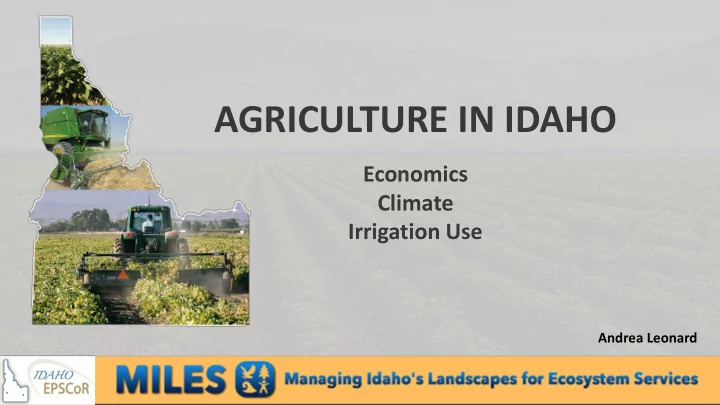

AGRICULTURE IN IDAHO Economics Climate Irrigation Use Andrea Leonard
Socio-Ecological Systems (SES) • Multi-level systems that involve bio-geo- physical components and the social systems they provide services to • Social and ecological systems are truly interdependent and constantly co- evolving and feeding off of each other • The delineation between social and ecological systems is arbitrary (Binder et al., 2013)
Agricultural Socio-Ecological System Technology Soils Policy Irrigation Personality Climate Economics Crops (Marten, 2001)
So What?
Global Data Global Agricultural Water Usage Irrigated systems • ~60% of global freshwater withdrawals go towards irrigation uses • Water use efficiency is increased in properly irrigated agriculture Rainfed systems • Productivity of rainfed systems depends on climate, which is variable (Fereres and Soriano, 2007)
Agricultural Water Usage • Climate change will alter spatial and temporal water demands in areas of domestic food production • Semi-arid regions will expand, making efficient irrigation even more essential for water conservation in these areas • Population growth will increase water stresses associated with agricultural production (Jin and Sridhar, 2012)
Research Questions In what way will climate change and climate variability impact agricultural production and irrigation use? How will human decisions and management practices (small/medium/large farms) affect crop yield and associated water use? What will integrating both of these social and biophysical systems reveal about regional water demand and use, crop distributions, and crop yields?
Study Area -Lower Boise River Basin -1300 square miles CropScape Agricultural Data from 2005-2014
Study Area Parma • Fertile soil of the region Wilder provide excellent conditions for Eagle Caldwell diverse agricultural products Boise Meridian • Anderson Ranch, Arrow Rock, Nampa and Lucky Peak reservoirs of the Boise River offer abundant water for irrigation • There are 3.2 million acres of irrigated land within the state. Photo: NASS CropScape on Google Earth Image
Study Area • 1 st in nation for the production Parma of potatoes Wilder Eagle Caldwell • Idaho is also known for its seed Boise Meridian industry producing 80-85% of Nampa the sweet corn seed produced in the world • 3 rd in nation for the production of alfalfa hay, hops, sugarbeets, mint, fresh prunes and plums, and milk Photo: NASS CropScape on Google Earth Image
Study Area Rapid population growth in the Parma Boise metropolitan area (~2%/year) Wilder Eagle Caldwell P = P 0 x e rt Boise Meridian Nampa P = 650,288 x e .02 x 35 By 2050, the population will be 1,300,504 – double the current population – if growth continues at this pace (Idaho Dept of Labor) Photo: NASS CropScape on Google Earth Image
CropSyst is a crop growth simulation model used to study the effect of cropping systems Biophysical System Social System management on farming productivity Crop Choice Precipitation Irrigation Use Temperature Technology CO 2 Concentration CropSyst Total Water Agricultural Use per unit Productivity area per unit area Introduction Objectives Methods Hypotheses
Scenario 2 Scenario 1 Small-sized Farm Mid-sized Farm -sustainable management -more sustainable management -efficient irrigation -water conservation -crop rotation -polyculture (multiple crops) -sells to local consumers Scenario 3 Large Industrial Farm -economically driven -inefficient water use -monoculture (one crop) -sells to other regions
Scenario 2 Scenario 1 Small-sized Farm Mid-sized Farm -sustainable management -more sustainable management -efficient irrigation -water conservation -crop rotation -polyculture (multiple crops) -sells to local consumers Scenario 3 Large Industrial Farm Climate Change -economically driven -inefficient water use Projections -monoculture (one crop) -sells to other regions
Outputs of Model Scenario 1 Scenario 2 Scenario 3 Water Use per unit area Water Use per unit area Water Use per unit area Crop Yield Crop Yield Crop Yield Scenario 1 Scenario 2 Scenario 3 WITH Climate Change WITH Climate Change WITH Climate Change Water Use per unit area Water Use per unit area Water Use per unit area Crop Yield Crop Yield Crop Yield
Envision • An agent-based modeling framework that uses socio-ecologic systems to produce alternative future scenarios • Uses point-based output from CropSyst to simulate water use and crop yield over a larger area • Provides a robust model that replicates a system sensitive to climate change and development
Hypotheses • As CO 2 increases with climate change crop yield per unit area will increase until a specific average temperature threshold is met, after which crop yield per unit area will decrease • More efficient farm management practices will result in less water use per unit area • Medium sized farms will succeed both ecologically and economically with climate change
Thank you for listening! Questions?
Recommend
More recommend